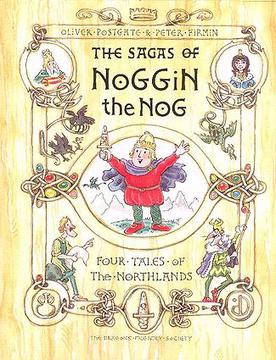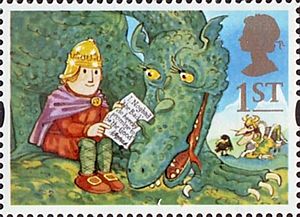Noggin the Nog facts for kids
Noggin the Nog is a much-loved British children's character. He starred in his own TV show and a series of illustrated books. The show was first shown between 1959 and 1965, and again in 1982. It was created by Oliver Postgate and Peter Firmin. Many people think the TV series is a classic from a special time in British children's television.
Noggin is a kind and simple King of the Northmen. His world is a bit like the Viking age, but with fun, imaginary things. These include dragons, flying machines, and even talking birds!
Peter Firmin, one of the creators, got the name "Noggin" from seeing Neasden station on the London Underground. It made him think of the name.
You can see some of the original drawings for the series at the Rupert Bear Museum. The way the characters looked was inspired by the Lewis chessmen. Peter Firmin saw these old chess pieces in the British Museum.
Contents
Meet Noggin and His Friends
The stories of Noggin the Nog are all about Noggin himself. He is the good-natured son of King Knut and Queen Grunhilda. When King Knut passes away, Noggin needs to find a queen to rule with him. If he doesn't, his tricky uncle, Nogbad the Bad, will take the crown!
Noggin meets and marries Nooka, an Inuit princess from the Nooks. Then he becomes the new king. Noggin and Nooka later have a son named Knut, who becomes important in future stories.
Here are some other main characters:
- Thor Nogson – He is Noggin's best friend and the leader of the Royal Guard. Nogson likes to say he is "fierce," but he is actually very kind. He is always loyal and ready to protect his king.
- Olaf the Lofty – Olaf is a clever inventor, but sometimes a bit proud. His inventions don't always work perfectly. However, his most famous success is the amazing Flying Machine.
- Graculus – This is a big green bird who first appears as Nooka's messenger. Later, Noggin and his friends meet Graculus's family. Unlike Graculus, his family cannot speak human languages.
- Grolliffe – Grolliffe is a friendly ice dragon. Noggin becomes friends with him, and Grolliffe helps Noggin and his friends in one of their adventures.
Most of the problems in the stories are caused by Nogbad the Bad. He never stops trying to take Noggin's throne. But Nogbad always loses in the end, even if Noggin doesn't always defeat him directly.
Noggin's TV Adventures
The first Noggin the Nog TV series started on September 11, 1959. It was shown by the BBC in the United Kingdom until 1965. The company that made the show, Smallfilms, created 21 episodes in black and white. They also made six episodes in colour. Each episode was about ten minutes long.
The show returned in 1982 with six new episodes, all in colour. This new series included one brand new two-part story. It also had a colour remake of an older story called "Noggin and the Ice Dragon." The animation style was simple stop-motion, but viewers still loved the series.
The show's title on screen was "The Saga of Noggin the Nog." This is because the stories were like old Norse sagas. Episodes often began with special words like: "Listen to me and I will tell you the story of Noggin the Nog, as it was told in the days of old." These openings had music played on a bassoon by Vernon Elliott.
The look of the characters was mostly inspired by the Lewis chessmen. These are old chess pieces from the Norse times. One story even shows Noggin playing chess with Nogbad the Bad! The complete series was released on DVD in 2005. This DVD set also included digital versions of the short story books.
Television Stories
Here are the different story collections, also known as sagas, that were shown on TV:
- The Saga of Noggin the Nog (also known as The King of the Nogs) (6 episodes) (black and white)
- episode 1 – The King
- episode 2 – The Ship
- episode 3 – The Journey
- episode 4 – The Island
- episode 5 – Nogbad the Bad
- episode 6 – The King of the Nogs
- The Ice Dragon (6 episodes) (black and white)
- 1 – The Little Man
- 2 – The Journey
- 3 – The Hot Water Valley
- 4 – The Dragon
- 5 – The Treasure
- 6 – Nogbad the Bad
- The Flying Machine (3 episodes) (black and white)
- 1 – The Jar
- 2 – The Birds
- 3 – The City
- The Omruds (3 episodes) (black and white)
- 1 – The Great Invention
- 2 – Under the Hill
- 3 – The Challenge
- The Firecake (3 episodes) (black and white)
- 1 – The Crown of Flowers
- 2 – The Dream
- 3 – The Sorcerer's Sword
- Noggin and the Ice Dragon (4 episodes) (colour) (a remake of the 2nd saga)
- Noggin and the Pie (2 episodes) (colour) (based on a book from 1971)
The stories were told by Oliver Postgate. The voices for the characters were done by Oliver Postgate and Ronnie Stevens. Oliver Postgate wrote the stories, and Peter Firmin drew the pictures. The music was created by Vernon Elliott.
Noggin's Books
Many short stories about Noggin were also published as books. One of these, Noggin and the Moon Mouse, even helped inspire the characters for the popular Clangers TV series! All the books were written by Oliver Postgate and had colourful pictures by Peter Firmin. They were published by Kaye & Ward.
Here are some of the "Starting to Read" books:
- Noggin The King (1965)
- Noggin and The Whale (1965)
- Noggin and The Dragon (1966)
- Nogbad Comes Back! (1966)
- Noggin and The Moon Mouse (1967)
- Nogbad and The Elephants (1967)
- Noggin and The Money (1973)
- Noggin and The Storks (1973)
There was also a series of 12 illustrated hardback books published in the 1960s and 1970s:
- King of the Nogs (1968)
- The Ice Dragon (1968)
- The Flying Machine (1968)
- The Omruds (1968)
- The Island (1969)
- The Firecake (1969)
- The Pie (1971)
- The Flowers (1971)
- The Game (1972)
- The Monster (1972)
- The Black-Wash (1975)
- The Icebergs (1975)
A larger book about Noggin's life, with black and white pictures, was also published:
- Nogmania (1977) (reprinted in 2000)
Two special "omnibus" books were released when the colour TV series came out:
- Three Tales of Noggin Volume 1 (1981) (This book included Noggin the King, Noggin and The Whale, and Noggin and the Moon Mouse)
- Three Tales of Noggin Volume 2 (1981) (This book included Noggin and the Dragon, Nogbad and the Elephant, and Noggin and the Storks)
In 1992, a big, colourful 96-page book called The Sagas of Noggin the Nog was published. It contained four stories: King of the Nogs, The Ice Dragon, The Flying Machine, and The Omruds.
Noggin's Special Recognition
Noggin received a very special honour that few characters ever get! He appeared on a British postage stamp in January 1994. The stamp showed Noggin and the Ice Dragon, with the dragon reading a note from Nogbad.
Peter Firmin, the artist, drew the picture for the stamp. He also made other drawings to help advertise the new stamps. This Noggin stamp was one of ten stamps that featured characters from British children's books. All the characters on the stamps were holding a letter or a message. Noggin's note on the stamp said: "I, Nogbad 'the Bad' do hereby promise to be 'the Good'."



